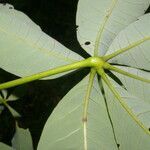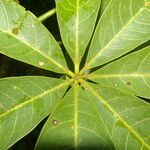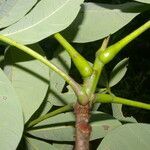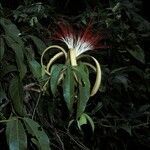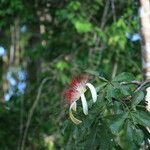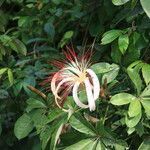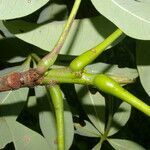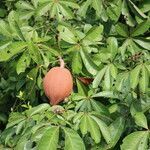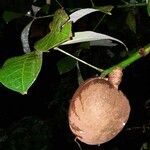Tree 5-23 m. high, the trunk attaining 25-60(-90) cm. in diam., sometimes buttressed, the crown spreading, the bark smooth, grayish to more or less brownish. Leaves 5-to 9-foliolate, the petiole terete, often longitudinally furrowed, dilated at both ends, 4-23.5 cm. long, glabrous; leaflets petiolulate, the petiolule thick, 0.3-2.5 cm. long, often furrowed above and glabrous; blade elliptic to oblong, sometimes lanceolate or slightly obovate, acute or rounded and more or less decurrent at the base, caudate-acuminate, caudate-apiculate or rounded-apiculate and generally mucronulate at the apex, 5-28.5 cm. long and 2.5-14.5 cm. wide, chartaceous to coriaceous, the margins sometimes slightly recurved, generally bright and glabrous above, dull, glabrous or sometimes scatteringly reddish-lepidote or finely tufted-pubescent or seldom lepidote and puberulous beneath, the nerves prominent es-pecially beneath. Flowers solitary or sometimes 2-to 3-nate, attaining 17.5-35 cm. long, the pedicel terete, 1-5.5 cm. long and 0.3-1.1 cm. thick, glabrous to shortly yellowish-brown-tufted-puberulous; receptacle 5-glandular, shortly puberulous to tomentellous with yellowish-brown tufted hairs; calyx campanulate, sometimes campanulate-tubiform, truncate or 5-apiculate, sometimes slightly 5-undulate-apiculate, 1.2-2.1 cm. long and 1.3-2 cm. in diam., shortly puberulous to tomen-tellous with yellowish-brown tufted hairs outside, silky-villose inside; petals acute to more or less obtuse, 17-34 cm. long and 0.8-2.1 cm. wide, greenish, yellowish or whitish, puberulous on both sides; stamens 200-260, 16-31 cm. long, whitish below and scarlet above, the staminal column 4.5-12 cm. long and 0.45-0.8 cm. in diam., tufted-puberulous; outer whorl with 5 dichotomous, epipetalous phalanges, each phalanx with numerous filaments; inner whorl with 5 episepalous phalanges, each phalanx with only 2-8 filaments; anthers ca. 3-5.5 mm. long, reddish; ovary pyri-form, 5-sulcate, ca. 0.5-1 cm. long and 0.45-1 cm. broad, shortly whitish-villose; style more or less dilated and 5-sulcate at the base, 19-31 cm. long, white below and reddish above, villous on the third inferior; stigma lobulate, the lobes ca. 2-3 mm. long. Capsule subglobose, ellipsoid to oblong-ellipsoid, shallowly 5-sulcate longitudinally, rounded to obtuse and emarginate at the apex, 12.5-30 cm. long and 6-10(-12) cm. in diam., the valves to 1. cm. thick, yellowish-brown-scabrous-puber-ulous outside, silky-villous inside; seeds generally 4-to 5-angular, 2-3.2 cm. x 2.2-6 cm. x 2-2.2 cm., the testa brownish.
More
Small trees 4-5(-18) m tall; young branchlets brown, glabrous. Petiole 11-15 cm, ferruginous stellate tomentose; leaflets 5-11, slightly petiolulate or subsessile, leaflet blade oblong to obovate-oblong, abaxially ferruginous stellate tomentose, adaxially glabrous, base cuneate, margin entire, apex acuminate; central leaflet 13-24 × 4.5-8 cm, size decreasing outward; midrib abaxially prominently raised, adaxially flat, lateral veins 16-20 per side of midrib, straight, connected near margin, veinlets thin and dense, prominently raised abaxially. Flowers solitary, axillary near twig tips. Pedicel robust, ca. 2 cm, yellow stellate tomentose, glabrescent. Calyx cup-shaped, nearly leathery, ca. 1.5 × 1.3 cm in diam., abaxially sparsely stellate pilose, adaxially glabrous, truncate or obscurely 3-6-toothed, persistent, with 2-3 globose glands at base. Petals yellowish green, narrowly lanceolate or filiform, up to 15 cm, distal half reflexed. Staminal tube short, proximally yellow, distally red, 13-15 cm including filaments; anthers 2-3 mm. Style dark red, longer than stamens; stigma minute. Capsule nearly pyriform, 9-10 × 4-6 cm, endocarp yellow-brown, thick, woody, abaxially glabrous, adaxially densely long woolly. Seeds many per cell, dark brown with white spirals, 2-2.5 × 1-1.5 cm. Fl. May-Nov.
An evergreen tree. It grows to a height of 7-18 m with a spread of 3 m. The trunk is erect and branches heavily. The leaves are large and compound like the fingers on a hand. There are up to 9 leaflets. The leaflets can be 30 cm long. The leaves are dark green and shiny. The flowers are cream with bright red tips. The petals are long and droop outwards. It is the red tips of the stamens that look like a shaving brush which gives it one of its common names. The flowers occur in long hanging groups. The flowers are short lived opening in the morning and falling by evening. The fruit is like a round pod. It can be 30 long and 15 cm across. The pod bursts open when ripe. The pod opens in about 5 sections. The seeds are round and 1-2 cm across. They are brown. They have a fleshy pulp. It is a good shade tree but other plants will not grow under it.
